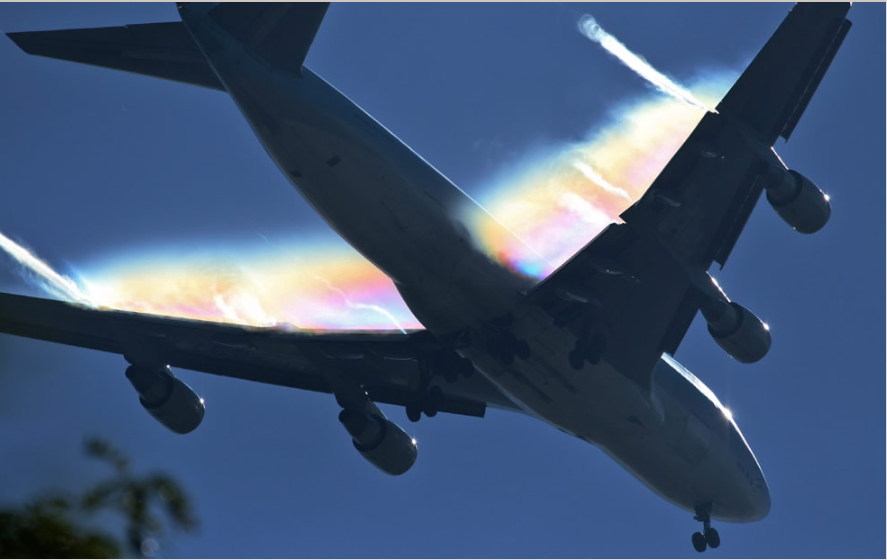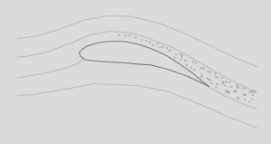Iridescent aircraft condensation cloud
Iridescent Aircraft Condensation Cloud: A Captivating Atmospheric Phenomenon
When we gaze up at the sky, we are often treated to breathtaking displays of natural beauty. One such mesmerizing sight is the iridescent aircraft condensation cloud. These stunning formations occur when sunlight interacts with countless tiny water droplets that have condensed due to the airflow over an aircraft's wings. In this article, we will delve deeper into the science behind these ethereal clouds and explore the conditions that give rise to their iridescent hues.
The Dance of Light and Water Droplets
The enchanting iridescence of aircraft condensation clouds is a result of a phenomenon called diffraction. When sunlight passes through these tiny water droplets, it undergoes a process of bending and spreading, creating a kaleidoscope of colors. The droplets responsible for this display have similar life histories and sizes, making them ideal candidates for iridescence. Furthermore, the angle at which the sun illuminates these droplets, typically 30-40° away, suggests their diminutive size.
The Science of Condensation
To understand the formation of these captivating clouds, we must first explore the process of condensation. When the pressure of water vapor in the air exceeds its saturation vapor pressure, it becomes unstable. If dust particles, known as nuclei, are present in the air, the excess vapor condenses into visible water droplets. However, in the absence of nuclei, the air becomes supersaturated, making condensation challenging. Nevertheless, under specific conditions, when the supersaturation surpasses a critical value, water can rapidly condense as a mist of fine droplets—a phenomenon known as homogeneous nucleation.
Wings: Catalysts for Iridescence
Aircraft wings play a crucial role in the creation of iridescent condensation clouds. As air flows over the top of an aircraft's wings, it accelerates, resulting in lower pressure and subsequent expansion. This expansion leads to a cooling effect. When the air humidity is sufficiently high, and the temperature is relatively warm (as warm air can hold more water vapor than cold air), conditions become favorable for heterogeneous or even homogeneous nucleation. Consequently, droplets form rapidly, and in some cases, the air may already be supersaturated before the aircraft passes through. The result is the mesmerizing sight of vapor trails emanating from the wings and other surfaces.
The Transient Nature of Droplets
In some instances, the droplets that form on the aircraft's wings evaporate quickly. However, they may also persist and join denser trails formed from the water produced by combustion in the engines. This interplay between evaporation and persistence contributes to the ever-changing nature of these ethereal clouds.
Unlocking the Secrets of Iridescent Aircraft Condensation Clouds
While we have explored the science behind iridescent aircraft condensation clouds, much remains to be discovered about these captivating phenomena. Researchers continue to study the intricate interplay between airflow, humidity, temperature, and droplet formation to gain a deeper understanding of these transient wonders. By unraveling the secrets of iridescence in the sky, scientists hope to shed light on broader atmospheric processes and refine our knowledge of atmospheric optics.
Conclusion
The iridescent aircraft condensation cloud is a captivating display of nature's artistry. The interaction between sunlight and countless tiny water droplets gives rise to an enchanting play of colors in the sky. By understanding the underlying scientific principles of condensation and droplet formation, we gain insight into the mechanisms that create these awe-inspiring phenomena. As we continue to explore and unravel the mysteries of iridescence in the atmosphere, we deepen our appreciation for the wonders that surround us in the ever-changing tapestry of the sky.

747 in landing approach to Schwechat Airport, Vienna imaged by astronomer Franz Kerschbaum (site) in late September 2007. Image ©Franz Kerschbaum, shown with permission.

The iridescence was produced by diffraction of sunlight by millions of water droplets condensed by the airflow over the wings. The droplets had similar life histories and therefore similar sizes, ideal conditions for iridescence. The sun was 30-40° away, indicating that the droplets were small.
Why does condensation occur? Once the pressure of water vapour in the air exceeds the saturation vapour pressure it is no longer stable. Provided there are dust particles present to act as nucle, the excess vapour over the saturation pressure condenses into droplets. Without nuclei, condensation is difficult and instead the air becomes supersaturated. However, when the supersaturation exceeds a certain critical value water does condense out very rapidly as a mist of fine droplets even though nuclei are absent. This is homogeneous nucleation.
The flow over the top of aircraft wings is faster than elsewhere. The fast flowing air is at a lower pressure and expands. In doing so it cools. If the air humidity is high enough and its temperature also fairly high (warm air can hold more water as vapour than cold air) then conditions might be reached for heterogeneous or even homogeneous nucleation followed by rapid droplet growth. In some cases the air might already be supersaturated before the aircraft passes. The result? We see trails of vapour from the wings and other surfaces (note the denser vortices in the Vienna image).
In the above illustartion the droplets evaporated quickly. Sometimes they persist to join the more dense trails formed from the water produced by combustion in the engines.
Note: this article has been automatically converted from the old site and may not appear as intended. You can find the original article here.
Reference Atmospheric Optics
If you use any of the definitions, information, or data presented on Atmospheric Optics, please copy the link or reference below to properly credit us as the reference source. Thank you!
-
<a href="https://atoptics.co.uk/blog/iridescent-aircraft-condensation-cloud/">Iridescent aircraft condensation cloud</a>
-
"Iridescent aircraft condensation cloud". Atmospheric Optics. Accessed on April 16, 2024. https://atoptics.co.uk/blog/iridescent-aircraft-condensation-cloud/.
-
"Iridescent aircraft condensation cloud". Atmospheric Optics, https://atoptics.co.uk/blog/iridescent-aircraft-condensation-cloud/. Accessed 16 April, 2024
-
Iridescent aircraft condensation cloud. Atmospheric Optics. Retrieved from https://atoptics.co.uk/blog/iridescent-aircraft-condensation-cloud/.